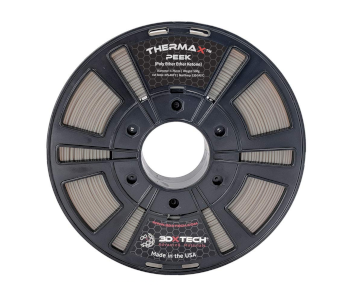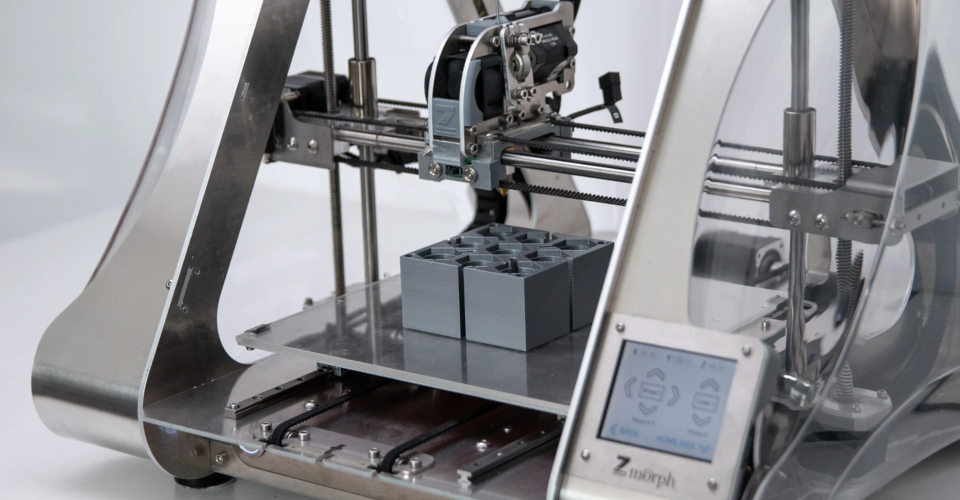What Makes PEEK and PEI Filaments So Special?
One of the reasons for the popularity of 3D printing using Fused Deposition Modeling (FDM) technology is the sheer variety of filaments that are now flooding the market. You can pick filaments according to how superior their mechanical properties are, or pick ones that make your finished print look good. This flexibility is something that other 3D printing technologies have not been able to catch up to.
One thing that FDM prints are not known for is durability. However, this may already be changing with the development of high-performance filaments like PEEK and PEI. What does PEEK and PEI offer that other filaments do not? Are there any challenges in using PEEK and PEI?
What is PEEK and PEI?
As a broad definition, both PEEK and PEI fall under the polyaryletherketone (PAEK) chemical group. PAEK is a class of semi-crystalline plastics known for their stability in high temperatures and exceptional mechanical strength. It is resistant to a number of environmental factors and chemical compounds, can handle heavy or sustained loads, and does not release toxic fumes when it burns or melts.
PEEK stands for Polyether ether ketone. It is manufactured using a stepwise polymerization process that takes place in very high temperatures. It has a useful operating temperature of up to 250 °C, a high resistance to biodegradation, and is chemically stable in organic or aqueous environments. It has a tensile strength of 90 to 100 MPa and a Young’s modulus of 3.6 GPa.
Before PEEK was used for FDM printing, it has been available in powder form and used for 3D printing via Selective Laser Sintering (SLS). It is only with fairly recent advancements in extrusion technology that PEEK (and PEI) has become usable in filament-based printing.
PEI stands for Polyether Imide. It is an amorphous plastic with a characteristic amber to transparent color. It has stable electronic properties, excellent chemical properties, and high strength. It was first developed by the Plastic Division of GE, specifically by Joseph Wirth, back in 1980s. Practically all PEI filaments available today carry the ULTEM brand, which is a family of PEI products manufactured by SABIC after they acquired GE’s Plastic Division in 2007.
One of the most notable achievements of the ULTEM brand was when the 3D printer-compatible ULTEM 9085 received aerospace certifications, promoting its use for 3D printing functional parts used for civil aircraft.
Differences between PEEK and PEI

Both PEEK and PEI have mechanical and chemical properties that put them leagues above the usual ABS or PLA filaments used in 3D printing. If so, what sets the two filaments apart?
1. Price
One of the top considerations when choosing between PEI or PEEK is price. PEEK can be several times more expensive than PEI. However, they are both much more expensive than your usual ABS or PLA filaments.
A 1-kilogram spool of PEI can set you back somewhere between $70 to $100. This may already sound daunting considering that you can get a similarly sized spool of PLA for less than $15. On the other hand, you might have to spend upwards of $500 for a 1-kilogram spool of PEEK. Most brands offer PEEK filament at spools as small as 250 grams to keep them at a friendlier price, but it’s still a huge investment.
When you need a 3D printed project with superior strength and temperature-resistance, PEI is the more cost-effective option. As we shall see later, PEEK still holds the advantage in terms of reliability.
2. Thermal stability
Both PEI and PEEK have relatively high glass transition and melting temperatures compared to the usual 3D printing filaments. That includes so-called high-temperature filaments such as ABS or Nylon. This has made PEI and PEEK excellent materials for engineering components that may have to endure a lot of friction or medical tools that need to be autoclaved regularly.
Between the two, PEEK remains stable at higher temperatures. PEI has a melting temperature of 240 °C and a glass transition temperature of 217 °C. On the other hand, PEEK melts at 400 °C and has a glass transition temperature of 250 °C. The specific values may vary from one brand to another, but the trends should be similar.
3. Mechanical strength
As with thermal stability, the mechanical properties of both PEEK and PEI are a league above other 3D printing filaments – even those that are known for strength like Nylon or PETG. When compared with each other, however, PEEK still holds the advantage.
Again, specific values may vary from one brand to the other. PEEK filament generally has a tensile strength of 90 to 100 MPa and a Young’s modules of 3.6 GPa. In comparison, PEI has a tensile strength of 85 MPa and a modulus of 3.2 GPa. This means that PEEK is both more rigid and stronger. The difference between the two may not sound like much, but it can be an important consideration if you are 3D printing components for engineering components.
4. Availability
PEEK has been around for a bit longer than PEI, mostly because of its use in SLS printing. This means that there are more choices for PEEK filaments, including those from big brands. Since these PEEK filaments are manufactured through different processes and have different additives, there’s a good amount of variety available in the market today.
In contrast, most PEI filaments are derived from the ULTEM brand. Since the same resin is used as the source for these PEI filaments, they will end up with fairly similar mechanical and chemical properties.
Applications of PEEK and PEI

The superior mechanical and chemical properties of PEEK and PEI make them exceptionally suitable materials for applications that require high-performance specifications. PEEK is routinely used for engineering components such as pump casings, piston parts, valves, and cable insulation. It has been used as a cheaper and lighter alternative to aluminum and other metals for automotive and aircraft parts. It is a preferred material in interior components since its flame-retardant properties pose less of a hazard in the event of a fire.
The chief advantage of PEI, particularly the ULTEM brand, is that it has already received several certifications, which include Flammability, Smoke and Toxicity, Joint Aviation Requirements, Federal Aviation Administration, and Airbus. Since all these certifications are aviation-related, PEI has been used in a wide range of aerospace components.
As a disclaimer, ULTEM has only been used on non-critical parts of aircraft. Although it’s a lighter and cheaper alternative to titanium and aluminum alloys, it has not undergone failure testing to a degree which makes it a viable material for critical aircraft parts.
One of the most recent uses of PEI has been in the Atlas V rocket by United Launch Alliance. Components of the rocket that used to be made of metal, including its ducting system, nozzles, brackets, and control panels, were manufactured using PEI. With PEI, the rocket enjoyed the benefits of a lower weight-to-size ratio, cheaper manufacturing, and lead time reduction.
Challenges of printing with PEEK and PEI
Despite their superior properties, it’s rare to encounter a 3D printing professional or hobbyist with experience in working with PEEK or PEI. Why is this the case? Here are a couple of possible reasons:
1. Availability of compatible printers
PEI prints at around 375 °C, while PEEK will require extruder temperatures of up to 400 °C. Accordingly, they will need to be printed on a bed heated to around 120 to 150 °C. These requirements are simply beyond the capabilities of many 3D printers, especially those that are used for desktop use.
It also isn’t a matter of simply upgrading one component of a printer. You’re going to need an upgraded heating element with an AC power supply, an upgraded thermistor for detecting temperatures up to 500 C, an all-metal hot end, a cooling mechanism for the stepper motors, an updated firmware, and repositioned electronics to protect them from the printer’s extreme temperatures. Because of such demanding requirements, there is just a handful of 3D printer models that work with PEI or PEEK.
2. Temperature control
Since PEI and PEEK print at extremely high temperatures, they are more prone to thermal stresses which may be introduced if the filament is cooled down too rapidly by external drafts. This means that you will certainly need an enclosure around your print chamber to maintain the internal temperature.
When NASA modified the LulzBot TAZ 4 3D printer to print with PEI, they even went as far as to install 35W halogen light bulbs to maintain the temperature of the build chamber.
Aside from keeping the filament fairly hot during the whole printing process, a thermal curtain also helps protect the electrical components from potential damage due to exposure to high temperatures. For this reason, 3D printers designed for PEEK and PEI deliberately have these electrical components located away from the print chamber.
3. Expensive
Probably one of the major considerations in why the use of PEEK and PEI isn’t so common is that it’s very expensive. As we’ve mentioned, there is just a handful of 3D printers that were designed to be compatible with PEEK and PEI. They are not just difficult to acquire, but also require a sizable investment.
Aside from needing to buy a high-end 3D printer that can work with PEEK or PEI, the filament themselves can cost several times more than the usual 3D printing filaments. This is especially true of PEEK, a 1-kilogram spool of which can cost more than $500. Although PEI is a little cheaper, it’s still much more expensive than the usual filament materials used in 3D printing. Thus, the price barrier of PEEK and PEI may be a bit too high for casual users or hobbyists who just want to experiment with it.
Final thoughts
3D printing was never just a hobby – it has always been considered a versatile manufacturing process with important industrial applications. It’s easy to forget this fact given all the inexpensive and fun 3D printing filaments that are available nowadays.
On the flip side, the PEEK and PEI filaments are a good reminder of the capabilities of 3D printing. Given that there are a lot of technical barriers to using PEEK or PEI, they are both exceptionally reliable filament materials that are used to craft critical engineering and aerospace components.


